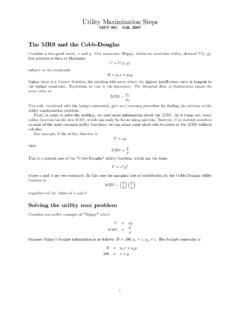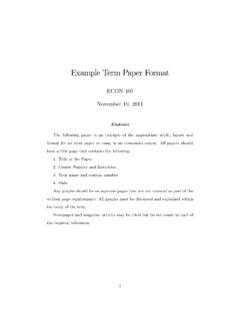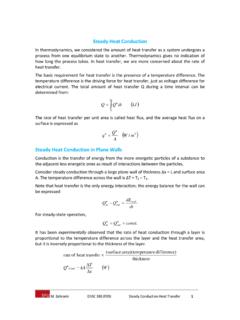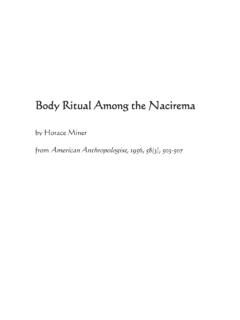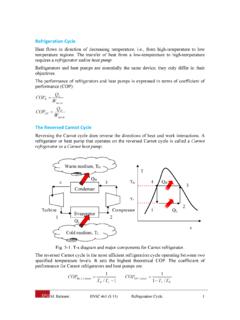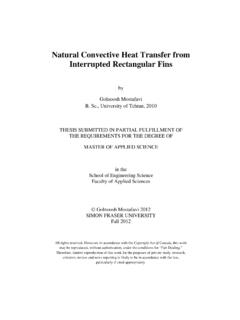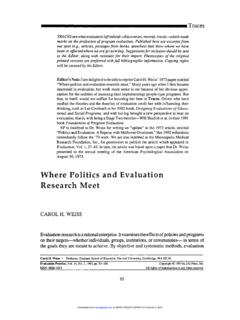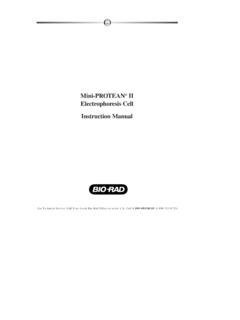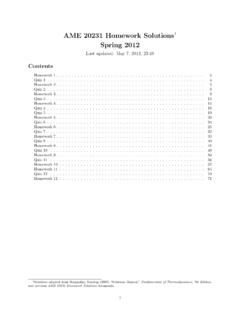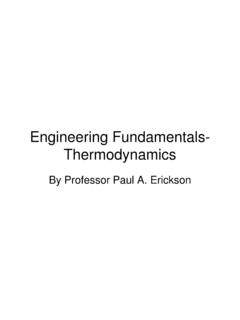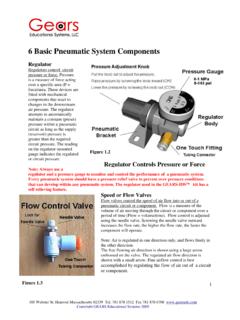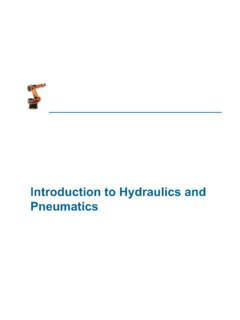Transcription of First Law of Thermodynamics Closed Systems
1 The First Law of Thermodynamics : Closed Systems The First law of Thermodynamics can be simply stated as follows: during an interaction between a system and its surroundings, the amount of energy gained by the system must be exactly equal to the amount of energy lost by the surroundings. A Closed system can exchange energy with its surroundings through heat and work transfer. In other words, work and heat are the forms that energy can be transferred across the system boundary. Based on kinetic theory, heat is defined as the energy associated with the random motions of atoms and molecules.
2 Heat Transfer Heat is defined as the form of energy that is transferred between two Systems by virtue of a temperature difference. Note: there cannot be any heat transfer between two Systems that are at the same temperature. Note: It is the thermal (internal) energy that can be stored in a system. Heat is a form of energy in transition and as a result can only be identified at the system boundary. Heat has energy units kJ (or BTU). Rate of heat transfer is the amount of heat transferred per unit time. Heat is a directional (or vector) quantity; thus, it has magnitude, direction and point of action.
3 Notation: Q (kJ) amount of heat transfer Q (kW) rate of heat transfer (power). q (kJ/kg) heat transfer per unit mass q (kW/kg) power per unit mass Sign convention: Heat Transfer to a system is positive, and heat transfer from a system is negative. It means any heat transfer that increases the energy of a system is positive, and heat transfer that decreases the energy of a system is negative. M. Bahrami ENSC 388 (F09) 1st Law of Thermodynamics : Closed Systems 1. Q = 5 kJ. System Heat out Heat in Q = 5 kJ. Fig. 1: Sign convention: positive if to the system, negative if from the system.
4 Modes of Heat Transfer Heat can be transferred in three different modes conduction, convection, and radiation. All modes of heat transfer require the existence of a temperature difference. Conduction: is the transfer of energy from the more energetic particles to the adjacent less energetic particles as a result of interactions between particles. In solids, conduction is due to the combination of vibrations of the molecules in a lattice and the energy transport by free electrons. Convection: is the mode of energy transfer between a solid surface and the adjacent liquid or gas which is in motion, and it involves the combined effects of conduction and fluid motion (advection).
5 Convection is called forced if the fluid is forced to flow by external means such as a fan or a pump. It is called free or natural if the fluid motion is caused by buoyancy forces that are induced by density differences due to the temperature variation in a fluid. Radiation: is the energy emitted by matter in the form of electromagnetic waves (or photons) as a result of the changes in the electronic configurations of the atoms or molecules. Work Work is the energy interaction between a system and its surroundings. More specifically, work is the energy transfer associated with force acting through a distance.
6 Notation: W (kJ) amount of work transfer W (kW) power M. Bahrami ENSC 388 (F09) 1st Law of Thermodynamics : Closed Systems 2. w (kJ/kg) work per unit mass w (kW/kg) power per unit mass Sign convention: work done by a system is positive, and the work done on a system is negative. ( ). Q. (+). System (+). W. ( ). Fig. 2: Sign convention for heat and work. Similarities between work and heat transfer: Both are recognized at the boundaries of the system as they cross them (boundary phenomena). Systems posses energy, but not heat or work (transfer phenomena).
7 Both are associated with a process, not a state. Heat or work has no meaning at a state. Both are path functions, their magnitudes depend on the path followed during a process as well as the end states. Path functions: have inexact differentials designated by symbol . Properties, on the other hand, are point functions which depend on the state only (not on how a system reaches that state), and they have exact differentials. 2. dV V. 1. 2 V1 V (Point function). 2. W W. 1. 12 (Path function, not W nor W2 - W1 ). Electrical Work The work that is done on a system by electrons.
8 When N coulombs of electrons move through a potential difference V, the electrical work done is: M. Bahrami ENSC 388 (F09) 1st Law of Thermodynamics : Closed Systems 3. We VN (kJ ). Which can be explained in the rate form as We VI (kW ). Example 1: Electrical work A well insulated electrical oven is being heated through its heating element. Determine whether it is work or heat interaction. Consider two Systems : a) the entire oven (including the heater), and b) only the air in the oven (without the heater) see Fig 3 3. Solution: The energy content of the oven is increased during this process.
9 A) The energy transfer to the oven is not caused by a temperature difference between the oven and air. Instead, it is caused by electrical energy crossing the system boundary and thus: this is a work transfer process. b) This time, the system boundary includes the outer surface of the heater and will not cut through it. Therefore, no electrons will be crossing the system boundary. Instead, the energy transfer is a result of a temperature difference between the electrical heater and air, thus: this is a heat transfer process. Electric Electric oven oven air air Heater Heater System boundary System boundary Fig.
10 3: Schematic for example 1. Mechanical work There are several ways of doing work, each in some way related to a force acting through a distance. W F .s (kJ ). M. Bahrami ENSC 388 (F09) 1st Law of Thermodynamics : Closed Systems 4. If the force is not constant, we need to integrate: 2. W F .ds (kJ ). 1. There are two requirements for a work interaction: there must be a force acting on the boundary the boundary must move Therefore, the displacement of the boundary without any force to oppose or drive this motion (such as expansion of a gas into evacuated space) is not a work interaction, W=0.
